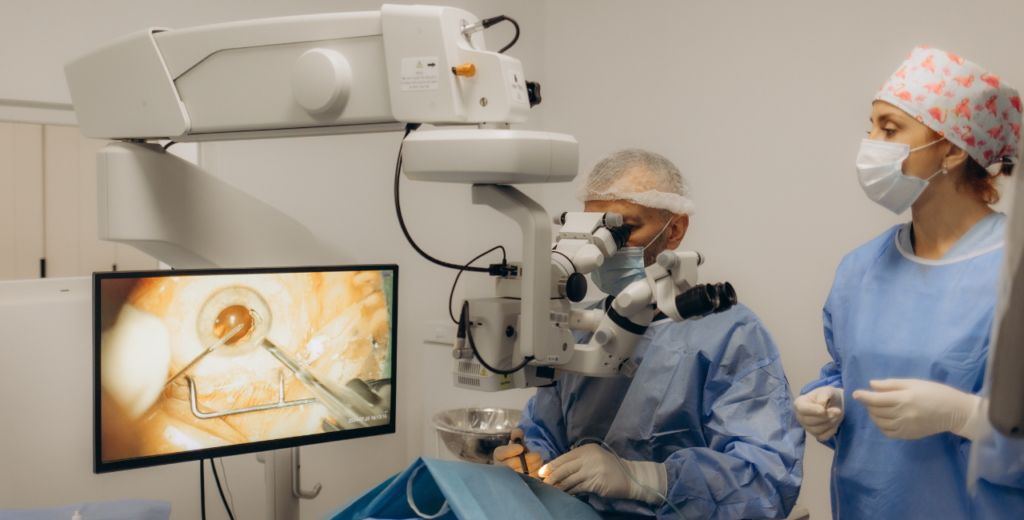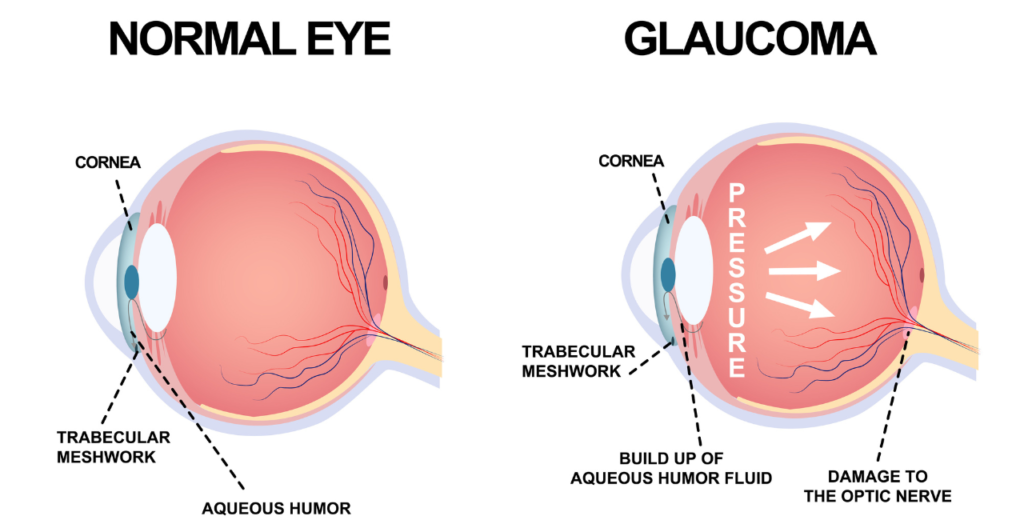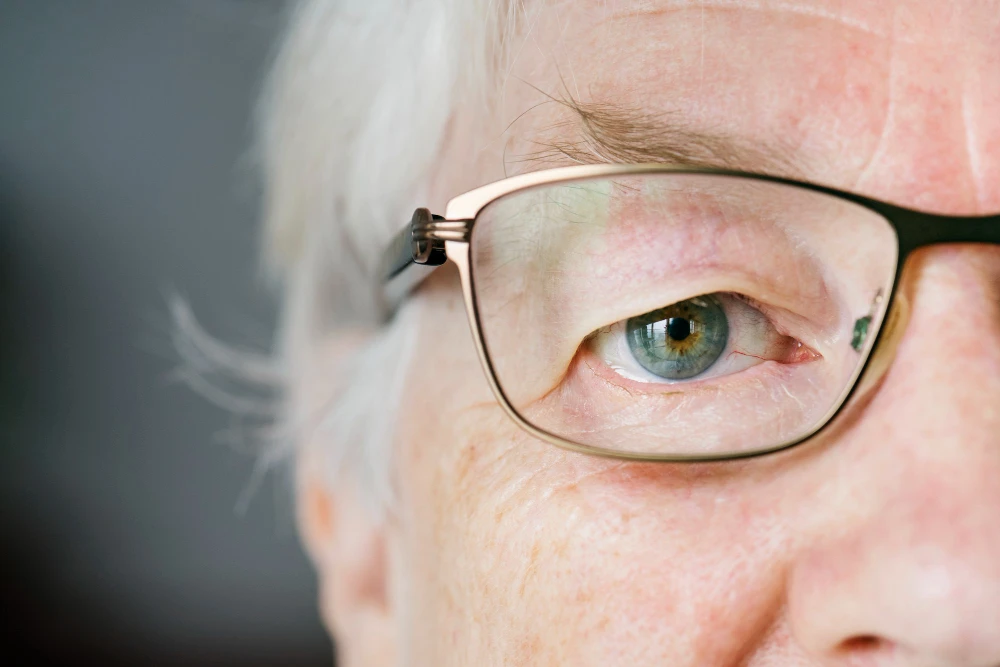A Progressive Eye Disease
Glaucoma, often called the “silent thief of sight,” is a chronic and progressive eye condition that leads to optic nerve damage due to an increase in intraocular pressure (IOP). If left untreated, glaucoma can cause irreversible vision loss, significantly impacting daily life. Early intervention through Glaucoma testing and treatment is crucial to slow progression and preserve eyesight.
Age-Related Risk Factors
- Increased Susceptibility After Age 60: Studies show that individuals over 60 are at a significantly higher risk of developing glaucoma, making routine eye exams essential for early detection.
- Genetic Predisposition: Those with a family history of glaucoma have an even greater likelihood of developing the condition, emphasizing the importance of regular screenings.
- Silent Progression: Many elderly individuals are unaware they have glaucoma because it develops gradually without noticeable symptoms in its early stages, often earning it the nickname “the silent thief of sight.”
When Is Surgery Recommended?
Surgical intervention is typically considered for older adults when other treatment methods prove insufficient. Situations that may necessitate surgery include:
- When Medications and Laser Treatments Are Ineffective
Prescription eye drops and oral medications are often the first line of defense for glaucoma. However, if they fail to adequately lower IOP or cause side effects, surgical options become necessary.
- For Advanced or Rapidly Progressing Glaucoma
If glaucoma continues to worsen despite ongoing treatment, surgery may be the best course of action to prevent further vision loss and stabilize the condition.
- Difficulty Following Medication Routines
Elderly patients with cognitive or physical impairments may struggle to maintain a strict medication regimen. Surgery can provide a long-term solution, reducing dependence on daily eye drops.
Preparing for Glaucoma Surgery
- Comprehensive Eye Examination: A thorough assessment is conducted to determine the severity of glaucoma and the most appropriate surgical approach.
- Medical History Review: Patients with diabetes, hypertension, or other underlying health conditions must undergo additional evaluations to ensure safe surgery.
- Preoperative Instructions: Patients may need to stop using certain medications and follow dietary restrictions before surgery.
Glaucoma Surgery Options
There are several surgical options available, ranging from minimally invasive procedures to more advanced interventions.
Glaucoma Laser Surgery
- Trabeculoplasty
- This outpatient procedure uses a laser to open the trabecular meshwork, improving the eye’s natural drainage system and lowering IOP.
- Recovery is quick, with minimal discomfort and a low risk of complications.
- Iridotomy
- Typically used for narrow-angle glaucoma, this procedure creates a tiny hole in the iris, allowing fluid to drain more effectively.
- It helps prevent sudden spikes in IOP, reducing the risk of acute glaucoma attacks.
- Cyclophotocoagulation
- A laser is applied to the ciliary body (which produces eye fluid) to reduce fluid production, lowering IOP in severe cases.
- This option is often reserved for advanced glaucoma when other treatments have failed.

Glaucoma Surgery Procedure
- Trabeculectomy
- The surgeon creates a new drainage channel in the eye to bypass the trabecular meshwork, significantly lowering IOP.
- Considered one of the most effective long-term treatments for glaucoma.
- Requires close postoperative monitoring to prevent scarring and complications.
- Glaucoma Drainage Devices (Tubes/Shunts)
- Small medical implants are placed in the eye to help drain excess fluid, reducing pressure and preventing further optic nerve damage.
- Often used for patients who do not respond to previous surgical interventions.
Minimally Invasive Glaucoma Surgery (MIGS)
- Lower-Risk Alternative
MIGS procedures involve smaller incisions and minimal tissue disruption, making them a safer choice for elderly patients with mild to moderate glaucoma.
- Shorter Recovery Time
The healing process is significantly faster compared to traditional surgeries, reducing postoperative complications.
- Combination with Cataract Surgery
Many older adults undergo MIGS alongside cataract surgery, improving both vision clarity and glaucoma management in a single procedure.
Postoperative Care and Recovery
- Regular Follow-Up Appointments:Routine check-ups help monitor healing progress and detect potential complications early.
- Activity Restrictions:Patients must avoid strenuous activities, heavy lifting, and bending over for a few weeks to prevent pressure buildup in the eye.
- Post-Surgery Medications:Prescribed eye drops aid in healing by reducing inflammation and preventing infection.
- Monitoring for Unusual Symptoms:Patients should immediately report any persistent pain, excessive redness, or abnormal discharge to their eye care provider.
Benefits of Glaucoma Surgery for Elderly Patients
- Reduced Dependence on Medications: Surgery can decrease or eliminate the need for daily glaucoma eye drops, which can be challenging to manage in old age.
- Prevention of Further Vision Loss: While surgery cannot restore lost vision, it is highly effective in preventing further deterioration, preserving the patient’s remaining eyesight.
- Enhanced Quality of Life: Maintaining good vision allows elderly individuals to continue daily activities independently, including reading, driving, and socializing.
- Long-Term Cost Savings: Although surgical procedures can be expensive upfront, they often reduce long-term costs associated with medications and frequent eye care visits.
Potential Risks and Considerations
While generally safe, glaucoma surgery does come with some risks:
- Infection Risk: As with any surgical procedure, there is a small risk of infection, which can be minimized with proper postoperative care and antibiotics.
- Possible Bleeding: Some patients may experience minor bleeding inside the eye, which can temporarily affect vision but usually resolves on its own.
- Scarring and Drainage Failure: In some cases, the surgically created drainage channels may scar over, reducing the long-term effectiveness of the procedure.
- Temporary Vision Changes: Patients may experience blurriness, light sensitivity, or mild discomfort for a few weeks after surgery.
- Longer Healing Process in Elderly Patients: Due to age-related factors, older adults may take longer to recover and require close follow-up with their eye care provider
Your Vision Matters: Get Expert Help Today
Glaucoma surgery offers an effective way to manage intraocular pressure and prevent further vision loss for older adults when medications and laser treatments fail. While it does not restore lost vision, it plays a crucial role in preserving remaining eyesight and improving overall quality of life.
If you or a loved one is facing glaucoma, don’t wait for vision loss to progress. Schedule a consultation at Vision Gallery today. Our experienced team of optometrists is dedicated to finding the best plan tailored to your needs.






